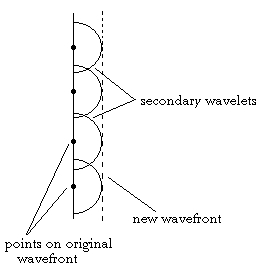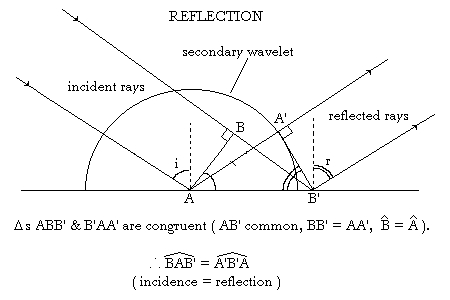5.1 Progressive Waves
5.2 Description of Waves
5.3 Reflection & Refraction
5.4 Huygens' Construction
5.5 Superposition of Waves
5.6 Stationary Waves
5.7 Interference & Diffraction
5.8 Sound Waves
5.9 Doppler Effect
5.10 Electromagnetic Waves
5.11 Polarization
5.1 Progressive Waves ( examples )
Waves transfer energy, no matter transfered (EM & Mechanical).

Transverse wave - particles vibrate at 90° to direction of motion ( e.g. waves on: water, strings ).
Longitudinal wave - particles vibrate in the direction of motion ( e.g. waves in air column, sound waves ).

Progressive - disturbance spreading outwards from a source ( fundamental - energy carried ).
Stationary - 2 progressive waves travelling in opposite directions. Shape of wave does not move through medium ( stays in position - energy stored ).
_________________________________________________
Wave profile:__wavelength ( l ), time period ( T ), phase relationship ( f ) - { between particles => time interval between particle maximums (y-axis) - as a fraction of period T. }


_________________________________________________

Phase changes on reflection: wave reflected at boundary going into denser medium ( vdense < v1 ), or phase change at barrier is 1/2 a wavelength on reflection.

_________________________________________________
- Predicts future position of a wavefront. Principle - "every point on a wavefront can be regarded as a source of secondary, spherical wavelets and the new wavefront will be the surface which touches all secondary wavelets."


_________________________________________________
- When 2 waves meet they produce disturbances at the points where they overlap, this is called superposition (as a resultant vector).
____ ____
____
Interference - 2 periodic waves of equal frequency & amplitude meet at a point. The resultant disturbance µ phase difference.
Disturbance in phase = 2 x individual waves (constructive interference)
Disturbance out of phase (180°) = zero resultant (destructive interference)
Phase difference depends on : 1) initial phase of both waves. 2) path difference - the distances travelled by the 2 waves.
Beats - 2 waves of ' » ' equal frequency meet at a point Þ varying phase difference between them.

Resultant frequancy, 
Beats are variations in the amplitude from the resultant superposition (1 beat cycle => after one wave completes one more oscillation than the other).
Beat frequency,  ____f1 > f2
____f1 > f2
_________________________________________________
A stationary wave is produced when 2 progressive waves (= frequency, amplitude) travelling in opposite directions overlap. This can be demonstrated from the resultant of 2 wave trains passing over each other.
_______
Table - Stationary vs Progressive Waves
| ... |
Stationary |
Progressive |
| Wave Profile |
Does not move in x-direction |
Moves through medium at speed v |
| ... |
Amplitude varies with time |
Constant amplitude* |
| Particles' Motion |
All particles between neighbouring node and antinode have different amplitudes |
All particles have the same amplitude |
| ... |
All particles between neighbouring nodes move in phase |
All particles in one wavelength are out of phase |
| Energy |
Stored on wave as vibrations |
Carried through medium by wave |
___________* unattenuated wave
Waves on Strings
_______
 (L - 1/2 wavength, v - speed of wave, n - number of nodes/harmonics, f - frequency)
(L - 1/2 wavength, v - speed of wave, n - number of nodes/harmonics, f - frequency)
 (T - tension, m - mass/length)
(T - tension, m - mass/length)
Experiment to investigate the relationship - f1 = (T/m)1/2/2L

from formula :  check relationships :_____f µ 1/L ,____f µ ÖT ,____f µ 1/Öm .
check relationships :_____f µ 1/L ,____f µ ÖT ,____f µ 1/Öm .
Waves in a Column of Air
 _____
_____

_________________________________________________
_________________________________________________
_________________________________________________
_________________________________________________
_________________________________________________
_________________________________________________
_
Copyright © 2005 Brendan Darrer
Web Page Design: B.Darrer
Page Last Updated: November 2005





















